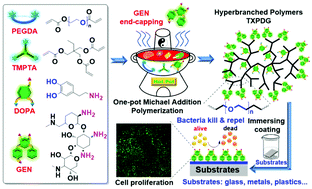A mussel-bioinspired multi-functional hyperbranched polymeric coating with integrated antibacterial and antifouling activities for implant interface modification†
Abstract
In recent years, infection-associated implant failures caused by bacteria intrusion and biofilm formation have become a severe threat to human health. To effectively solve these problems, the functional modification of the implant interface is considered to be promising strategy for inhibiting bacterial infection after implantation. However, the modification processes still face some limitations, including complicated procedures, unitary function and high cost. In this work, mussel-bioinspired hyperbranched polymeric coatings (TXPDG) are elaborately designed and synthesized via the Michael addition reaction of poly(ethylene glycol) diacrylate (PEGDA) and dopamine (DOPA), utilizing trimethylolpropane triacrylate (TMPTA) and gentamicin (GEN) as branching and end-capping agents, respectively. By means of adjusting the molar ratios of the reactants, a series of TXPDG coatings with controllable branching degrees (BD) and GEN content were successfully obtained and used for the interface modification of diverse substrates via a facile immersion process, which can be attributed to the universal adhesion of catechol pedants in the molecular structure. The firmly formed T20PDG coating on the substrate surface exhibits excellent antibacterial performance towards both Gram-negative Escherichia coli and Gram-positive Staphylococcus aureus because of the GEN terminal groups. In addition, BSA protein adsorption assessment confirms that these TXPDG polymeric coatings also show prominent antifouling properties, rendering the heterogenous resistance of the implant surface to prevent serious stimulus response. More importantly, TXPDG polymeric coatings present remarkable biocompatibility, with no negative influence on the spreading and proliferation of the MC3T3-E1 cells. Overall, this work not only describes a strategy for the design and synthesis of multi-functional hyperbranched polymers, but also reveals the potential applications of functional polymeric coatings on the interface modification of implants to prevent infection-associated implantation failure.



 Please wait while we load your content...
Please wait while we load your content...